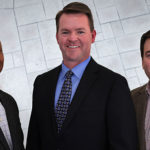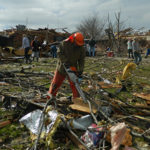If Baptists intend to build a denomination that looks like America—or Texas, for that matter—then we’ve got a long way to go.
A new study by the Pew Research Center tracks the racial and ethnic diversity of 29 U.S. religious groups, including myriad Christian denominations, several world religions and three subsets of religiously unaffiliated Americans. It assigns adherents to five racial/ethnic categories—Asian, black, Latino, mixed-race/other and white.
 Editor Marv KnoxThe Pew study indexes the groups on a zero-to-10 scale, with zero representing non-diversity and 10 representing absolute diversity. An evenly divided group—composed of 20 percent from each racial/ethnic category—would rank 10. A group composed of only one category would rank zero.
Editor Marv KnoxThe Pew study indexes the groups on a zero-to-10 scale, with zero representing non-diversity and 10 representing absolute diversity. An evenly divided group—composed of 20 percent from each racial/ethnic category—would rank 10. A group composed of only one category would rank zero.
Clay Price, information analyst for the Baptist General Convention of Texas, provided comparable numbers for the BGCT.
The U.S. adult racial/ethnic diversity index is 6.6, the Pew Center reported. Our nation is 66 percent white, 15 percent Latino, 12 percent black, 4 percent Asian and 4 percent mixed/other.
Texas’ diversity index is 8.0, Price noted. Our state is 47 percent white, 37 percent Hispanic or Latino, 12 percent black, 4 percent Asian and 2 percent mixed/other.
Seventh-Day Adventists most diverse
Religious groups’ diversity ranged from the Seventh-day Adventist Church, which received a 9.1 index ranking, to the National Baptist Convention, with a 0.2 ranking. The Adventists are 37 percent white, 32 percent black, 15 percent Latino, 8 percent Asian and 8 percent mixed/other. The National Baptists, who have created and maintained a convention for African-American Baptists, are 99 percent black and 1 percent other.
Perhaps most surprisingly, Muslims ranked second on the diversity index, at 8.7. Blacks, which comprise 28 percent of U.S. Islamics, strongly propelled the diversity. U.S. Muslims also are 38 percent white, 28 percent Asian, 4 percent Latino and 3 percent mixed/other.
Sign up for our weekly edition and get all our headlines in your inbox on Thursdays
Rounding out the top five groups are Jehovah’s Witnesses, with an 8.6 rank; Buddhists, 8.4; and “nothing in particular,” or the so-called “nones,” 6.9. Catholics, shaped by a surge of Latinos, who comprise 34 percent of U.S. adherents, came in sixth, with a 6.7 rank—just above the national average.
Other Baptist groups
Three other Baptist groups float in the middle of the pack:
• American Baptist Churches USA merited a 5.5 rank. The ABC, which is strongest in the East and Midwest, is 73 percent white, 11 percent Latino, 10 percent black, 5 percent mixed/other and 1 percent Asian.
• The Baptist General Convention of Texas tracks a 4.6 rank, Price said. The BGCT’s complexion is 78 percent white, 13 percent black, 8 percent Latino and 1 percent Asian.
• The Southern Baptist Convention’s demographics create a 3.4 rank. The SBC is 85 percent white, 6 percent black, 5 percent mixed/other and 3 percent Latino.
The gap of 1.2 points between the BGCT’s diversity rank and the SBC’s rank is not as broad as it might appear, Price observed. “The SBC’s index of 3.4 is about half (52 percent) the U.S. adult index of 6.6,” he explained. “The BGCT’s index of 4.6 is just over half (58 percent) the Texas adult index of 8.0.”
A couple of factors—one negative and one positive—have contributed to the BGCT’s diversity index rank, Price said.
BGCT losing churches
The BGCT, which relates to the Southern Baptist Convention but also permits churches to relate to the Cooperative Baptist Fellowship and the Baptist World Alliance, continues to lose churches—the vast majority of which are Anglo—to a competing convention in the state, which relates exclusively to the SBC, he noted.
In the past five years, 124 churches moved from the BGCT to the other convention, he said. Of those, 118—or 95 percent—are predominantly Anglo.
Conversely, “the bulk of new BGCT church starts has continued to be largely non-Anglo congregations,” he added. From 2010 through 2014, the BGCT and its affiliated churches started 489 congregations, of which 89 percent are non-Anglo.
As has been noted previously—both here and here— Texas Baptists face a tremendous challenge.
The racial and ethnic diversity of BGCT congregations more closely mirrors the state’s demography than does our membership. According to Price’s analysis, our congregations are more diverse—57 percent white, 19 percent Latino, 15 percent black, 5 percent mixed/other and 4 percent Asian. Those numbers indicate we’re heading in the right direction.
Start more Hispanic congregations
But we need to start even more congregations, particularly aimed at Hispanics. And we need to equip all congregations to reach their neighbors with the gospel.
In today’s culture, the compelling nature of the gospel will be demonstrated through relationships and response to human need. We will gain a hearing and validate the gospel message when more and more Texas Baptists and their churches focus on what Jesus said he came to do—proclaim good news to the poor, freedom for prisoners of all kinds, recovery of sight for the blind, freedom for the oppressed and “the year of the Lord’s favor” (Luke 4:18-19).














We seek to connect God’s story and God’s people around the world. To learn more about God’s story, click here.
Send comments and feedback to Eric Black, our editor. For comments to be published, please specify “letter to the editor.” Maximum length for publication is 300 words.